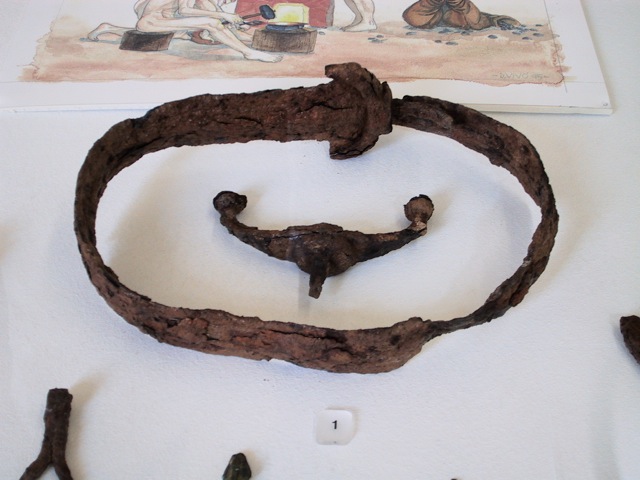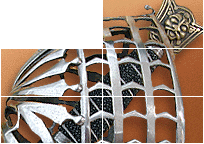| Author |
Message |
|
Stephen Curtin
|
 Posted: Thu 13 Jan, 2011 3:08 pm Post subject: Antennae hilts? Posted: Thu 13 Jan, 2011 3:08 pm Post subject: Antennae hilts? |
 |
|
Hey guys.
I'm wondering if anybody here could help me with info on late bronze age and early iron age swords with antennae hilts? I've been looking online but can't seem to find out too much. As far as I've been able to find out antennae style hilts began in the late urnfield culture and carried on into the hallstatt and villanovan cultures, but thats about it. I would like to know; how they developed, how common they were, as well as, what areas they were used in, and just about any other piece of info that you think might be helpful. Thanks in advance.
Éirinn go Brách
|
|
   |
 |
|
Richard Hare
Location: Alberta, canada Joined: 15 Mar 2008
Posts: 135
|
 Posted: Fri 14 Jan, 2011 6:04 am Post subject: Posted: Fri 14 Jan, 2011 6:04 am Post subject: |
 |
|
Hi Stephen,
I don't know if I should say this here, but if you go to "Bladesmith Forum" there is a history section, and I know there is some talk and photos on there re. antennae hilts.
It seems the one in the Brit. Museum is about the longest, and most of the others are more dagger length.
Some of the members here I know for sure are well aquainted with this hilt, so they may soon address this for you.
Good luck!
Richard.
|
|
   |
 |
|
Stephen Curtin
|
 Posted: Mon 17 Jan, 2011 1:09 am Post subject: Posted: Mon 17 Jan, 2011 1:09 am Post subject: |
 |
|
I'm still looking for some info if anyone here has any, thanks.
Éirinn go Brách
|
|
   |
 |
|
Peter Johnsson
Industry Professional
|
 Posted: Mon 17 Jan, 2011 1:47 am Post subject: Posted: Mon 17 Jan, 2011 1:47 am Post subject: |
 |
|
There is an interesting article in Gladius on Iberian antennae hilts.
These are contemporary to the Central European Hallstatt antennae daggers, but are (at least to begin with) longer: proper sword length weapons: slim profile and strong midrib (up to 75 cm blade length).
go here for the complete article:
http://gladius.revistas.csic.es/index.php/gla...ewFile/2/2
I really like to look of these swords and plan to make a version (...any year now ;-).
Below is an example from Girona. It is interesting in that the antennae are more akin to the Hallstatt form and yet have a blade that is long and slim like its spanish fellows. At the time I estimated blade length to about 75 cm and with over guard to about 6,5 cm. Width of antennae 12 or 13 cm (it now looks to me the antennae are more like 10 cm across...).
 Attachment: 79.59 KB Attachment: 79.59 KB

|
|
   |
 |
|
Stephen Curtin
|
 Posted: Wed 19 Jan, 2011 5:50 am Post subject: Posted: Wed 19 Jan, 2011 5:50 am Post subject: |
 |
|
Hi Peter and thanks for that article, I actually forgot all about the antennae hilts from the iberian peninsula. For the moment though, I'm trying to find out about examples from the urnfield and hallstatt cultures (and maybe the villanovan as well) thank again for the reply though Peter.
Éirinn go Brách
|
|
   |
 |
|
Jeroen Zuiderwijk
Industry Professional
|
 Posted: Sat 22 Jan, 2011 1:53 pm Post subject: Posted: Sat 22 Jan, 2011 1:53 pm Post subject: |
 |
|
Here's a quick overview of the evolution of antenna hilted swords from the late bronze age:
http://1501bc.com/files/vollgriffschwerter%20...%20103.jpg
After this, during the early iron age, the antenna hilted swords disappeared from most of Northern Europe. They were replaced by Gundlingen and then Mindelheim style swords during the Hallstatt C period. The antenna hilted swords or daggers continue to exist in some parts of southern and eastern Europe, but I don't have a clear view of those. During the Hallstatt D period, swords disappear alltogether in Northern Europe, and are replaced by daggers. These daggers are highly variable in design, some antenna hilted, others all kinds of unique designs. In Spain, they are mostly antenna hilted AFAIK. At the transition from Hallstatt to La Tene, it seems that the latest antenna hilted swords evolve into both the anthropomorphic daggers and La Tene swords, which then spread throughout Europe, and replace the Hallstatt daggers.
N.b. the antenna hilt was also popular among the Scythians, who applied it to there Akinakes, right around the time they started to disappear in Northern Europe. It's possible they copied the design from Eastern European examples. They spread this design all across the steppes into Asia. I've even seen examples from Korea and an one supposedly left behind by invading steppe people in Japan. The same goes for antenna hilted knives, of which nearly identical examples are found from central Europe up to China. It's tempting to think that these are all linked, and that the design managed to spread so far. But it could just as well have been invented in several places around the same time.
Jeroen Zuiderwijk
- Bronze age living history in the Netherlands
- Barbarian metalworking
- Museum photos
- Zip-file with information about saxes
|
|
   |
 |
|
Stephen Curtin
|
 Posted: Sun 23 Jan, 2011 4:03 am Post subject: Posted: Sun 23 Jan, 2011 4:03 am Post subject: |
 |
|
Thanks you very much Jeroen this was very helpful. So now my focus has shifted to these Hallstatt D daggers. I wonder do you happen to hav any info or good online resources for these. Thanks.
Éirinn go Brách
|
|
   |
 |
|
|

